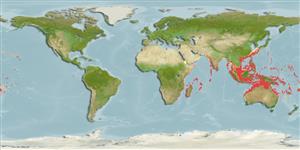Environment: milieu / climate zone / depth range / distribution range
นิเวศวิทยา
เกี่ยวกับทะเล,น้ำเค็ม เกี่ยวกับหินโสโครก; ไม่มีการอพยพย้ายถิ่น; ระดับความลึก 10 - 150 m (Ref. 9710), usually 20 - 150 m (Ref. 9710). Tropical; 34°N - 32°S, 31°E - 158°W (Ref. 5222)
Indo-Pacific: east coast of Africa (Djibouti, Socotra to Durban) to the Line Islands, north to southern Japan, south to southern Queensland (Australia). Not found at the Chagos Archipelago despite intensive survey and not reported from the Red Sea and Persian Gulf.
Length at first maturity / ขนาด / น้ำหนัก / Age
Maturity: Lm ?, range 28 - ? cm
Max length : 57.0 cm TL เพศผู้/กระเทย; (Ref. 5222); common length : 30.0 cm TL เพศผู้/กระเทย; (Ref. 5450)
เงี่ยงครีบหลัง (รวม): 9; ก้านครีบอ่อนที่หาง (รวม): 14-16; เงี่ยงครีบก้น 3; ก้านครีบอ่อนที่ก้น: 9. This species is distinguished by the following characters: body depth greater than or subequal to head length, 2.3-2.7 times in standard length (for specimens 9-41 cm SL); dorsal head profile of adults straight to concave, the nape distinctly convex; pectoral fins subequal to pelvic fins, 1.5-1.7 times in head length for specimens of 15-40 cm length (in specimens larger than 40 cm, the pelvic fins are longer than the pectoral fins); pelvic fins reaching to or beyond anus; ctenoid body scales, cycloid on abdomen. Colour: Adults from Pacific Ocean generally pale reddish to yellowish brown, covered with numerous small brownish red or dark brown spots on head, body, and fins; while the juveniles are dark reddish brown to nearly black, the rear margin of caudal fin and sometimes pectoral fins whitish; or body brownish orange with scattered pale greenish spots, and black spot between upper and middle opercular spines (Ref. 39231, 90102).
Adults occur in deep lagoon reefs and steep outer reef slopes and in coastal areas with rocky substrates. Juveniles are usually found near sponges or coral heads (Ref. 9710). Adults usually at moderate depths with bommies with large holes, usually occupied by cleaner shrimps (Ref. 48635). They are solitary (Ref. 90102) and are usually caught in depths of 30 to 100 m, but in Madagascar, they occur in depths of 10 to 20 m. They feed on small fishes and crustaceans including shrimps, crabs and stomatopods (Ref. 37816). Females mature at about 28 cm SL and males at about 34 cm SL (Ref. 6448). Are sold in Hong Kong live fish markets (Ref. 27253). They are generally marketed fresh (Ref. 5284) and of commercial importance throughout most of its range. They are primarily caught with hook-and-line, spear, and in traps (Ref. 39231).
Life cycle and mating behavior
วัยเจริญพันธุ์ | การสืบพันธุ์ | การวางไข่ | เซลสืบพันธ์ของเพศเมีย(ไข่) | ความดกของไข่ | ตัวอ่อน
Heemstra, P.C. and J.E. Randall, 1993. FAO Species Catalogue. Vol. 16. Groupers of the world (family Serranidae, subfamily Epinephelinae). An annotated and illustrated catalogue of the grouper, rockcod, hind, coral grouper and lyretail species known to date. Rome: FAO. FAO Fish. Synop. 125(16):382 p. (Ref. 5222)
IUCN Red List Status (Ref. 130435)
Threat to humans
Harmless
Human uses
การประมง: การค้า
เครื่องมือ
Special reports
Download XML
แหล่งที่มาจากอินเตอร์เน็ต
Estimates based on models
Preferred temperature (Ref.
123201): 21.2 - 29, mean 27.6 °C (based on 2728 cells).
Phylogenetic diversity index (Ref.
82804): PD
50 = 0.5000 [Uniqueness, from 0.5 = low to 2.0 = high].
Bayesian length-weight: a=0.01318 (0.01062 - 0.01636), b=3.05 (3.02 - 3.08), in cm total length, based on LWR estimates for this species (Ref.
93245).
ระดับชั้นอาหาร (Ref.
69278): 3.8 ±0.60 se; based on food items.
ความสามารถในการกลับคืนสู่ปกติ (Ref.
120179): ขนาดกลาง, เวลาต่ำสุดที่จะทำให้ประชากรเพิ่มขึ้นเป็น 2 เท่าใช้เวลา 1.4 - 4.4 ปี (Fec = 42,252).
Fishing Vulnerability (Ref.
59153): Moderate vulnerability (43 of 100).
Nutrients (Ref.
124155): Calcium = 36.1 [19.1, 59.7] mg/100g; Iron = 0.452 [0.251, 0.846] mg/100g; Protein = 18.5 [16.7, 20.2] %; Omega3 = 0.164 [0.103, 0.266] g/100g; Selenium = 50.5 [26.0, 86.5] μg/100g; VitaminA = 84.2 [31.1, 255.9] μg/100g; Zinc = 0.812 [0.561, 1.304] mg/100g (wet weight); based on
nutrient studies.
